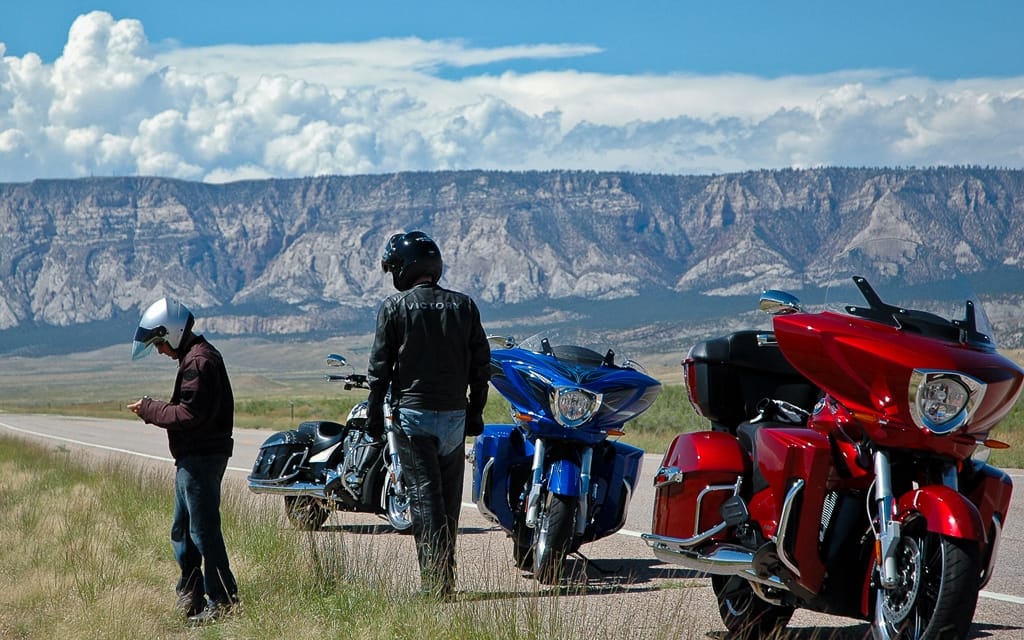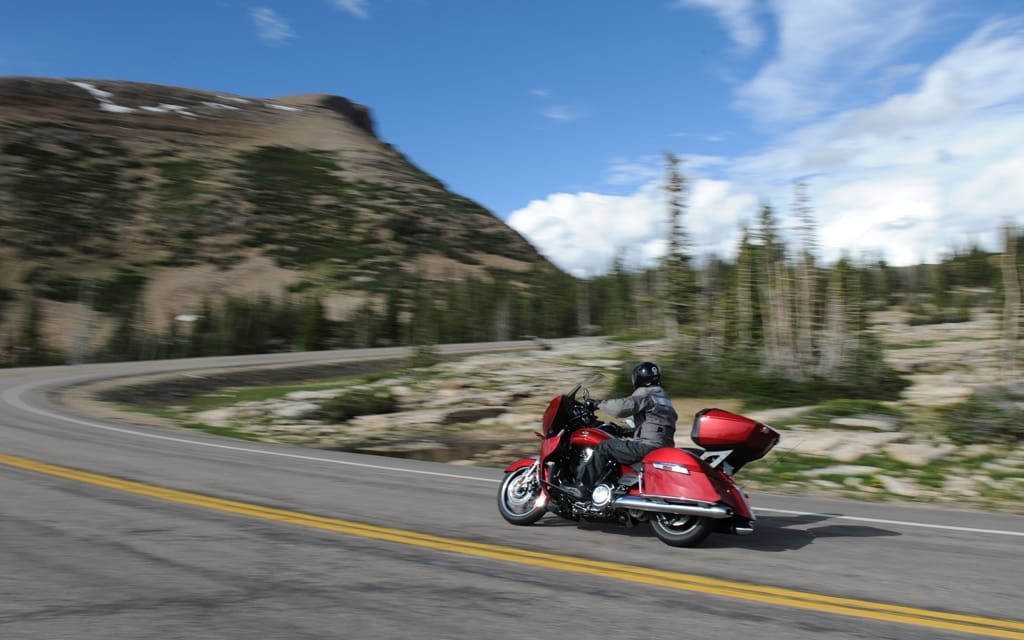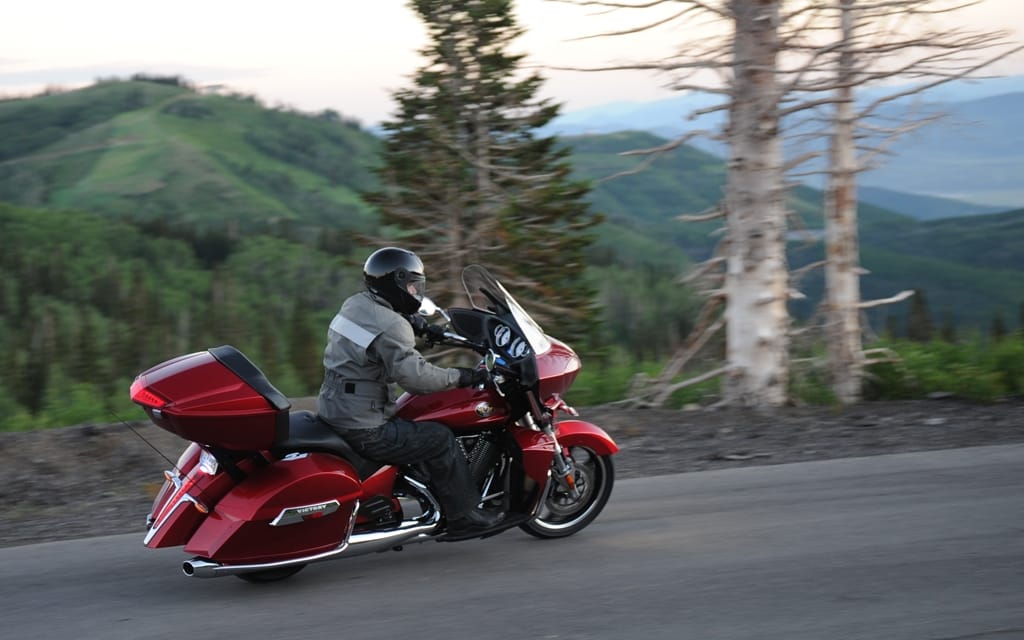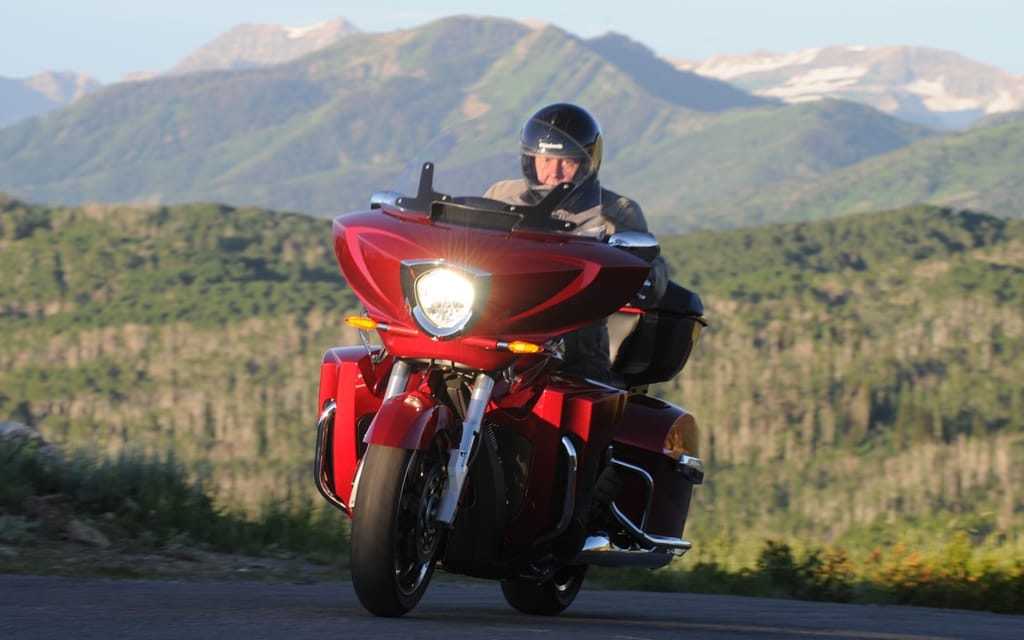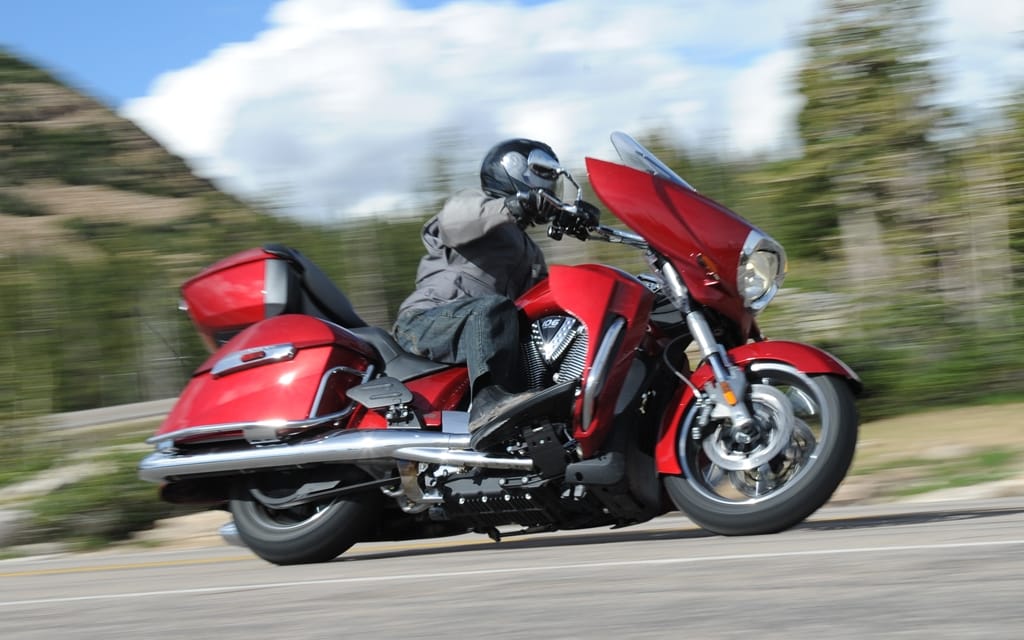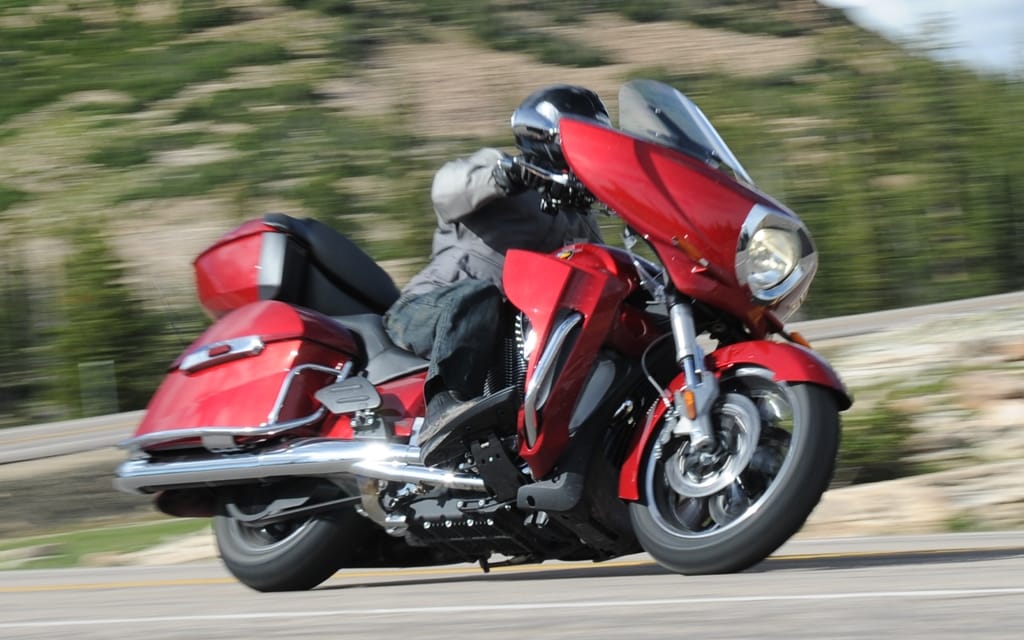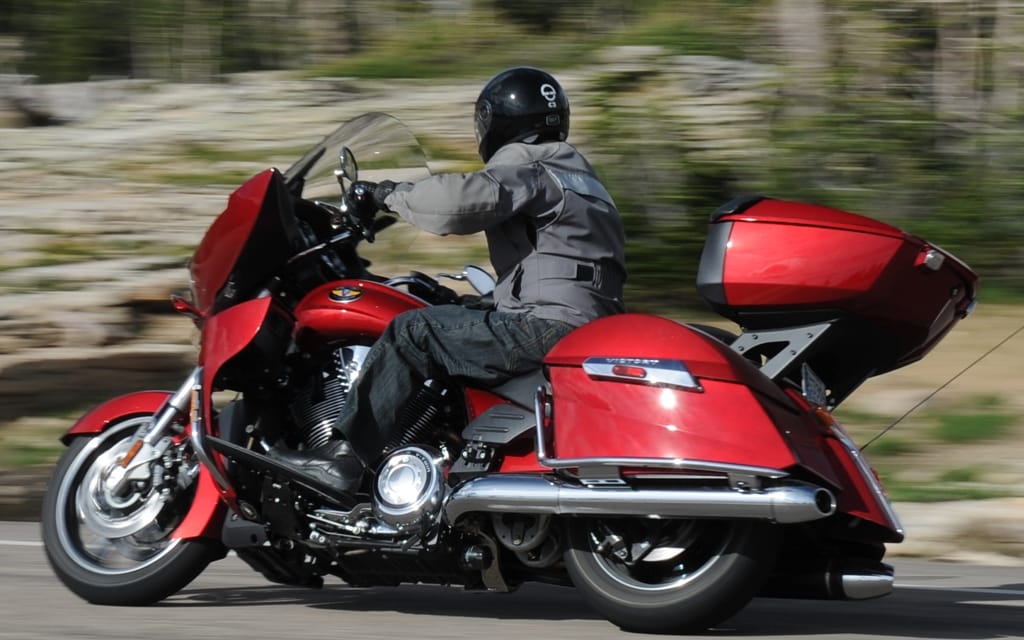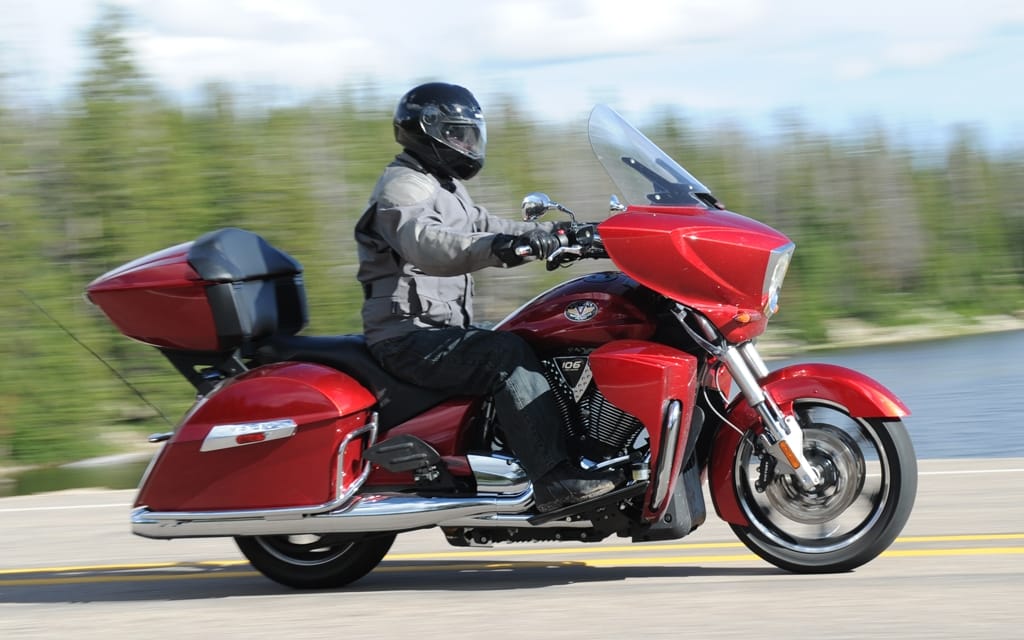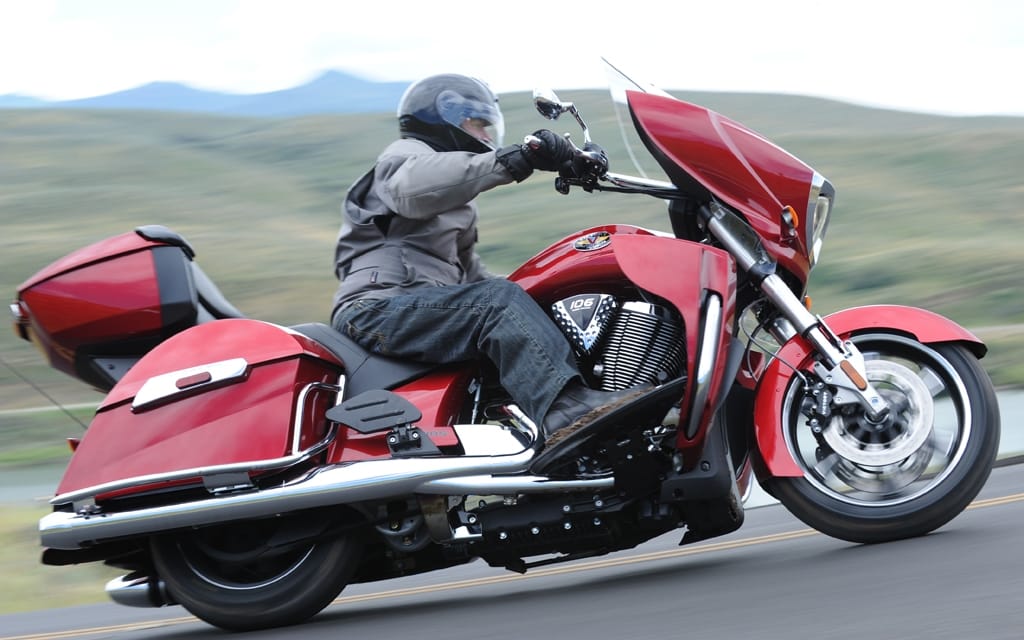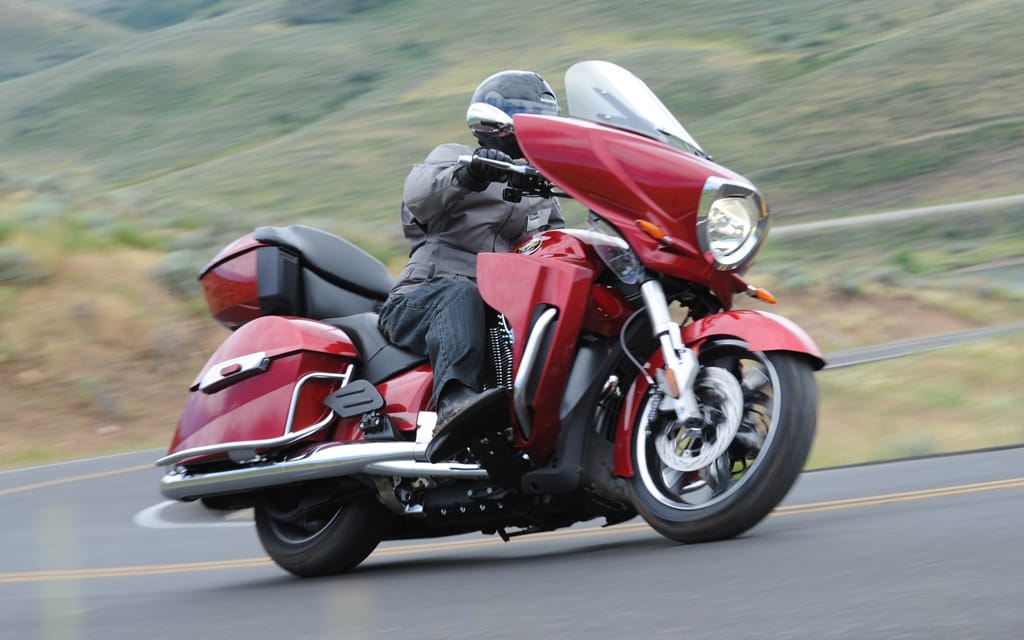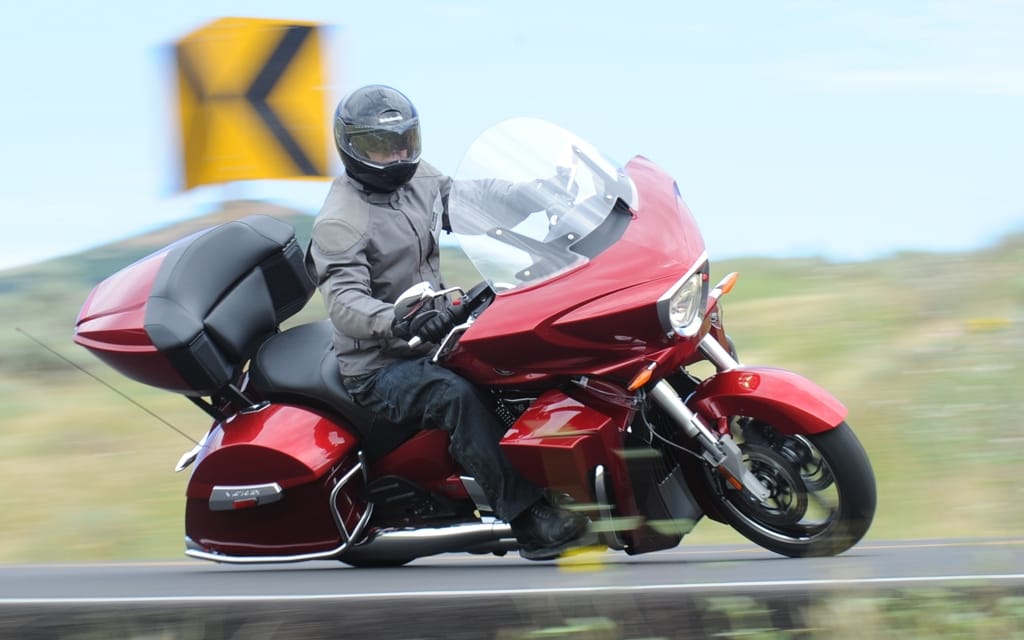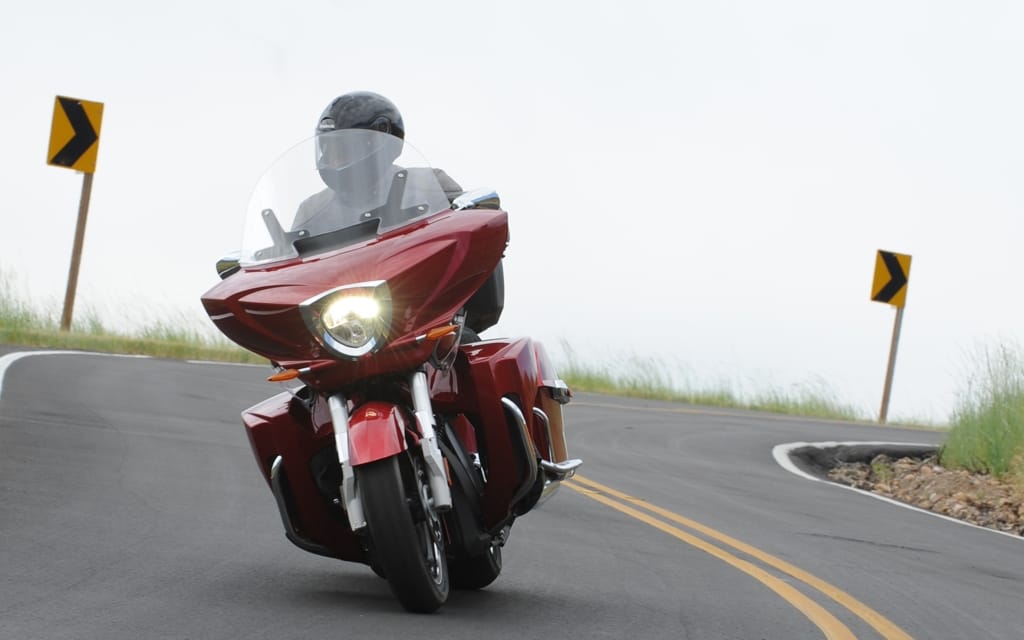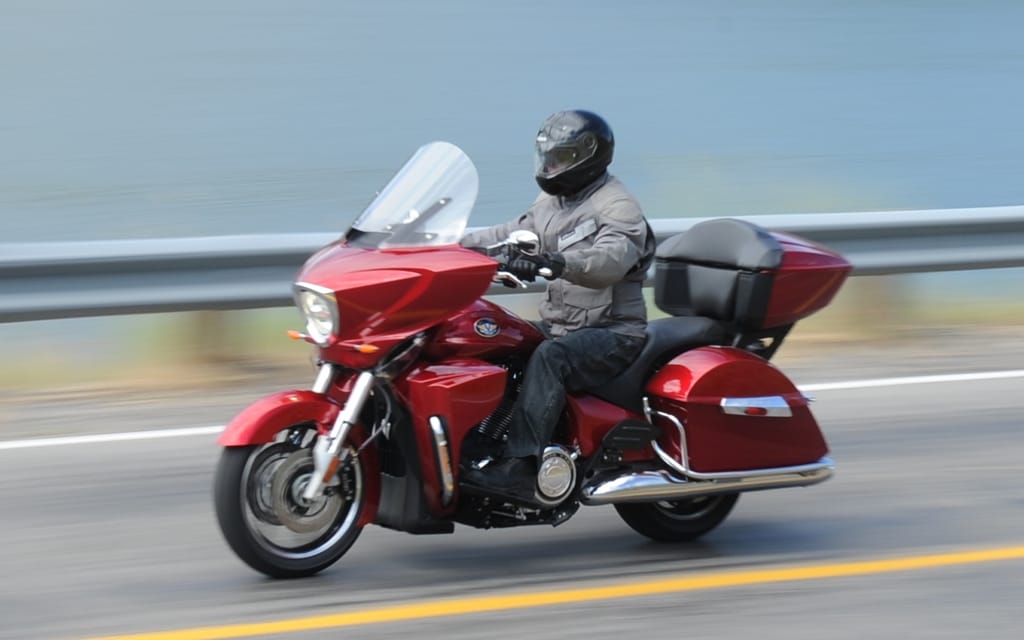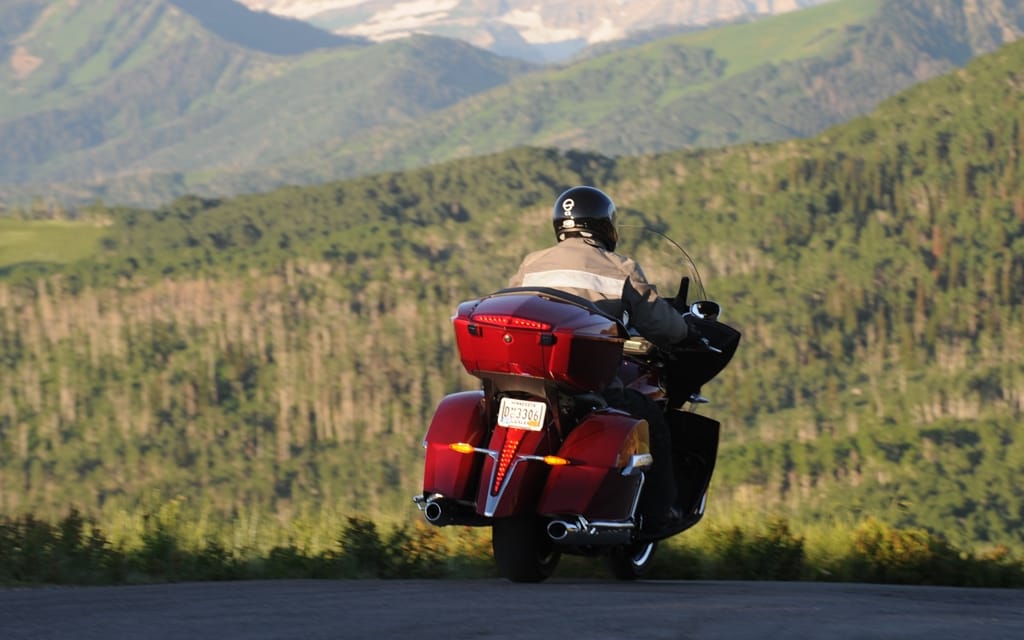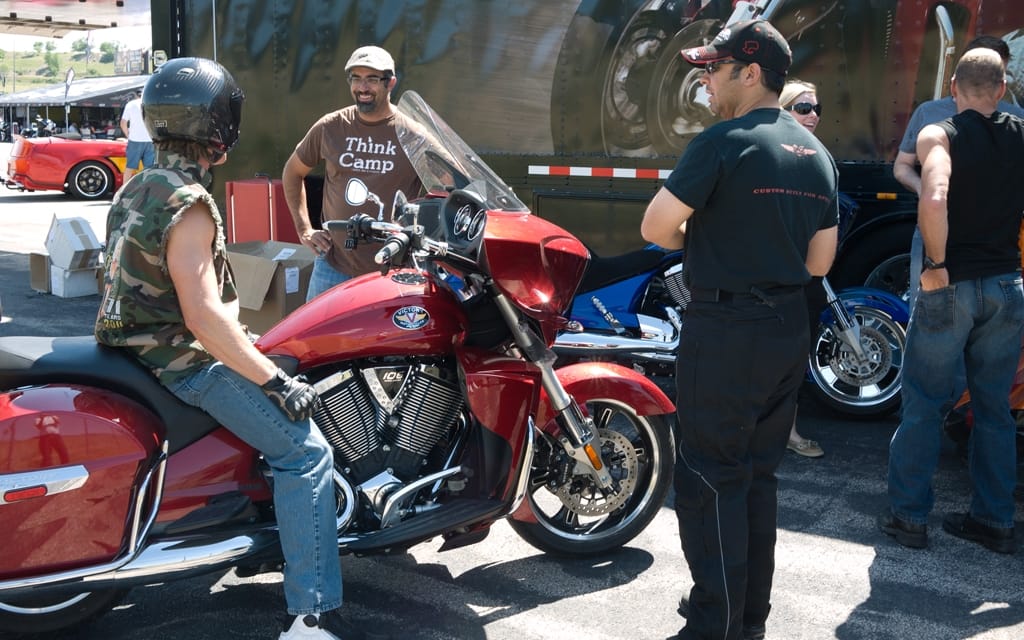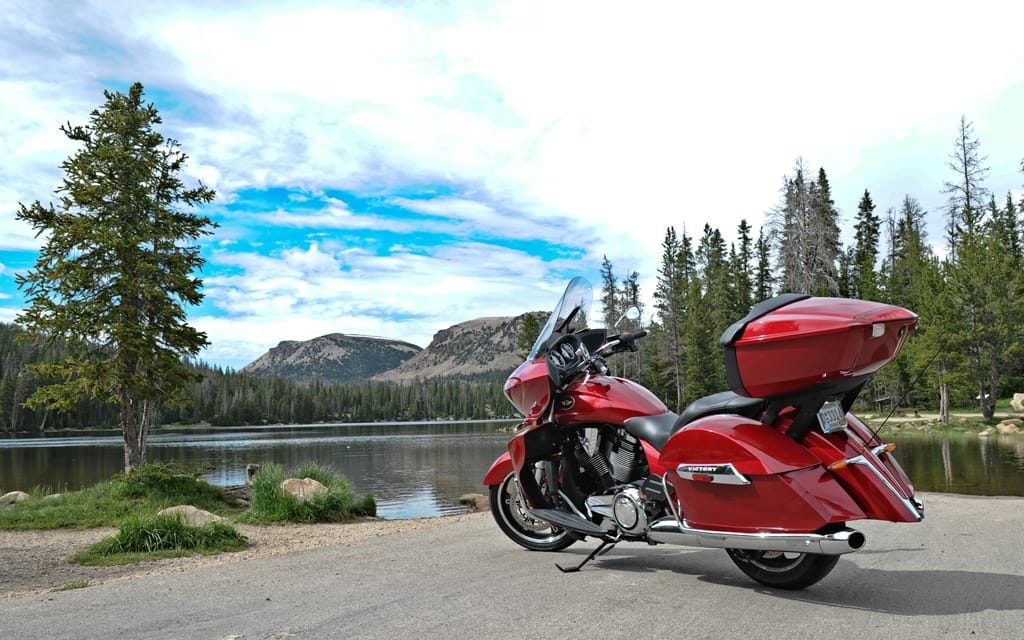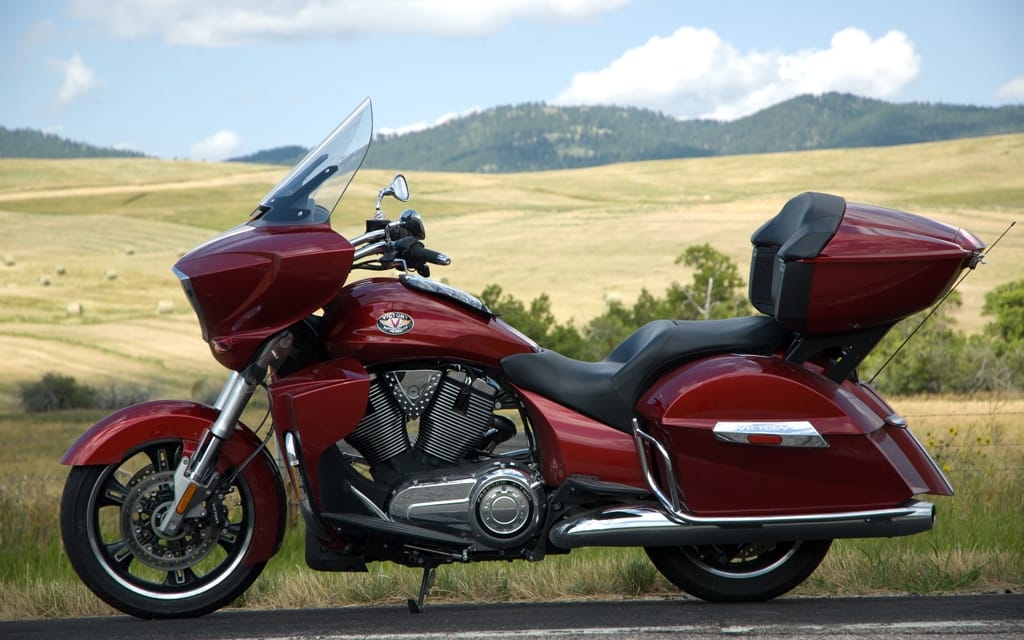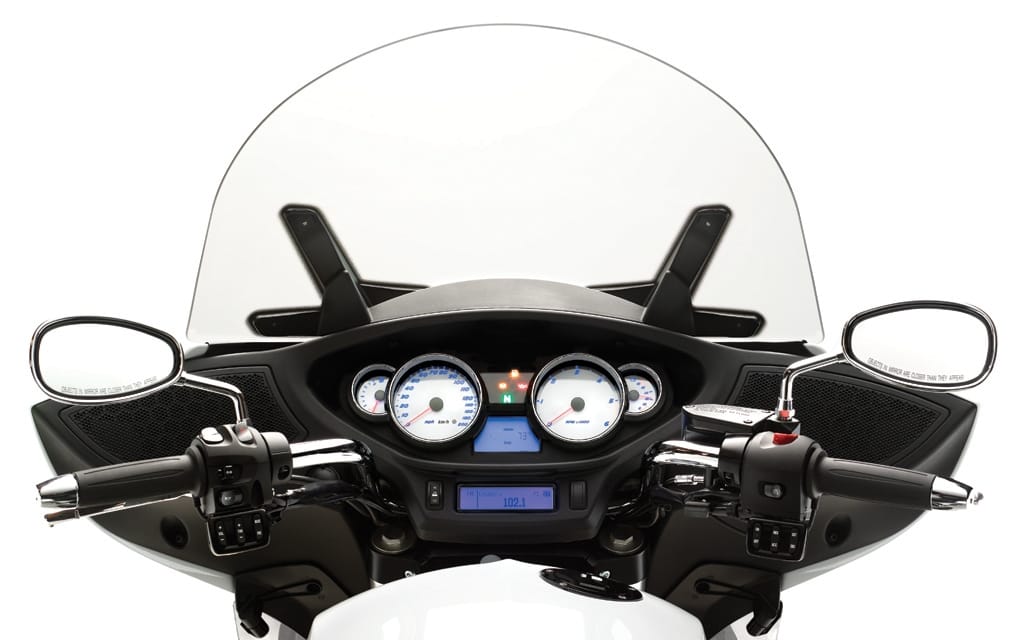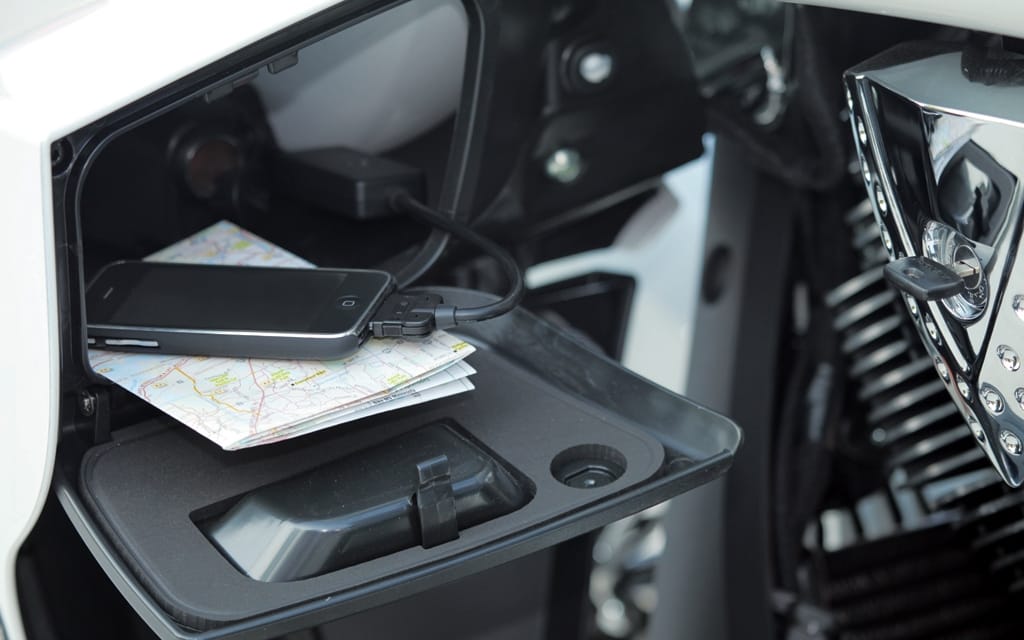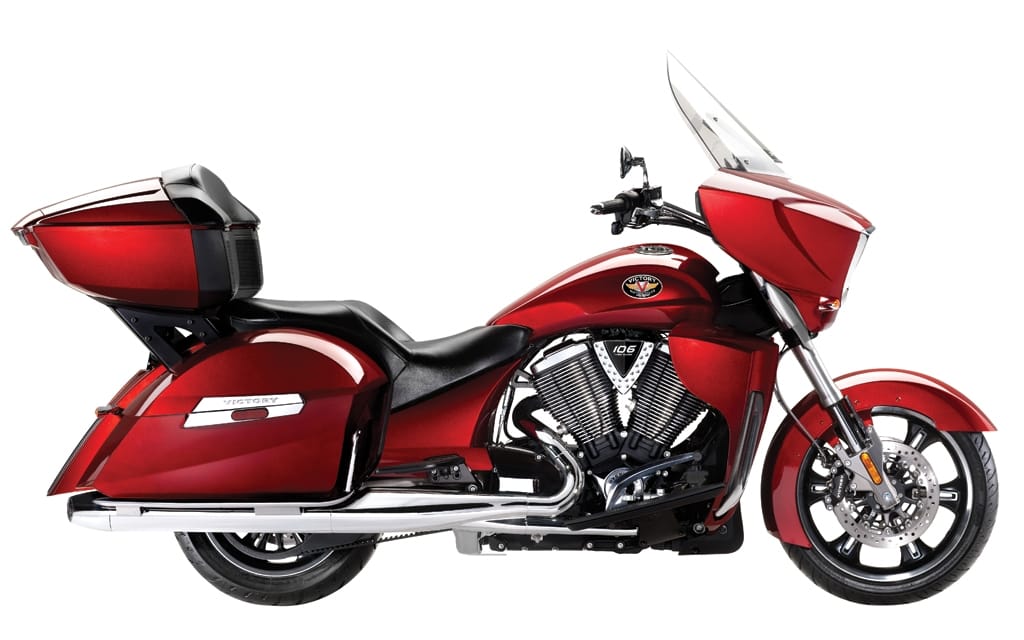The speakers at a Victory Motorcycles press briefing had not minced words when they described the new Cross Country Tour to a pack of assembled journalists: “This is the most comfortable bike in the world,” they had claimed. “It is a benchmark for all touring motorcycles.”
Despite having its own bar set distractingly high, the Cross Country Tour made a good first impression, and quickly showed itself to be a versatile motorcycle. Once, when turning off the highway onto what looked like a dirt field, I ran into a patch of ankle-deep mud. The bike squirmed under me as the front tire became a toboggan, and my left foot was immersed in mud, but nearly 400 kg of fueled-up Victory stayed upright, and credit for that should probably not go to the operator. (Claimed dry weight is 384 kg.)
Fortunately, most of the Cross Country Tour’s riding was done on pavement. Over the course of three days we rode from Salt Lake City, Utah, to Sturgis, South Dakota, a distance of about 1,000 miles. A true touring bike should do more than get you from A to B in comfort, with luggage. It should get you a hundred miles past B, in the rain, without significant discomfort. The Tour managed some of that very well.
There were a number of features that backed up the claims of those Victory speakers. The passenger floorboards, for instance, could be rotated through a 10-degree arc, and could be moved two inches vertically, and the luggage capacity was quite possibly class-leading: I had brought with me a spare helmet and leather jacket, expecting company later in the week, and I found that my clothing, the extra gear, and two cameras would fit into the locking saddlebags and top box, with room to spare.
Our group consisted of media wrangler Robert Pandya and his brother Manny, a couple of other Victory representatives, and some journalists from Canada and the United States. Magazine writers rode the new touring model, but Robert was on a Vision, his brother took a Cory Ness Signature Cross Country (at $28,399 MSRP, the most expensive Victory motorcycle available; the Cross Country Tour that we rode retails for $23,999), and there was a Hammer (a cruiser model) as well. The journalists had flown to Salt Lake City and met at a hotel to pick up their touring bikes. From there, we rode to a hotel in Park City, Utah, about 30 miles away. Someone had left my bike’s seat heater turned on, and I didn’t find the activation switch until we reached our destination. It was a hot afternoon, and the heater was on at full strength. There are two switches, located under the left edge of the seat; they’re easy enough to use while riding, if you know where they are. They’re threeway switches, and in High position, they produce a lot of warmth. There are also some effective handgrip heaters, though I only used them above about 9,000 feet of altitude.
That would be in Colorado, where we cruised through the Arapaho National Forest and Rocky Mountain National Park. The Continental Divide pushes the land up into great ridges that are paved in smooth, high-speed sweepers, and along the edge of one long slope we passed a herd of elk, maybe 50 of them, and then, far below, a small lake with a cloud-patched sky reflected on the mirror of its surface. At 12,000 feet it was cool, but people were dressed for the August heat, and we passed a couple of girls in skirts, playing on a snowfield. The high-mountain air was chilly even at low speeds, but the Cross Country Tour’s windscreen, eight inches higher than on the previous year’s standard Cross Country, moved oncoming air around the rider.
Coming down from a high pass half an hour later, we stopped for a traffic jam, then continued downhill with engines turned off. The slope was steep enough that we needed to use brakes from time to time, and at one point, Manny slowed, then released the brakes and let gravity accelerate him toward a left-hander. The heavy Cory Ness Cross Country coasted almost silently into the turn, and then the footboard hit pavement and threw up a grinding screech that seemed louder for the absence of engine noise. We cruised for seven miles down that slope, dropping 2,000 feet according to Manny’s GPS app, and by the time we had to restart engines, the air had become warm.
There, again, the Cross Country Tour is kitted for comfort; in fact, it’s a “Comfort Control System” that the touring model employs for massaging the airflow onto the rider. Four wind deflectors are located in the large fairing, one pair in front of the knees, another pair in front of the handlebar. The lower panels are meant to be operated by a kick, but, as with the seat heaters, it becomes important to understand the operation of these things prior to riding, or you’ll find yourself looking down at a wind deflector tab when you should be steering a motorcycle. Strangely, opening both lower wind doors drew more heat onto my legs; apparently, an open door can let engineheated air pass onto the rider. Opening those doors also increased wind noise. Experiments revealed that the left top and bottom right wind deflectors should be opened for the quietest and coolest ride.
All Victory touring models are equipped with ABS, and a gear with more than the ,usual number of teeth is employed to improve response times of the system.A firm hand on the brake lever would trip the anti-skid system very quickly, and it cycled rapidly off and on, with a lower amplitude of feedback to the rider than I remember sensing on other bikes; it was fast and smooth, in other words.
At fuel stops, we lined up to use the same pump, letting Robert assume responsibility for paying, and fuelling up was made quicker by a neat modification of the Tour’s fuel tank filler neck. Gas can be pumped at full speed without a spill if the nozzle is inserted from the left side of the tank. That saves a few seconds on a fill, but even better, it saves having to mop up overflowed gasoline.
There is a small hatch on the left side of the fairing for an iPod or other MP3 player, which can be run through the excellent stereo system, but I noticed at one fill-up stop that my iPhone was dangling out the door of this hatch, secured by its hook-up cord.
On the second day, Robert and Manny split off from the group with photographer Barry Hathaway on another Victory, and reasoning that Robert knew the way ahead, as well as noticing that he tended to ride quickly, led me to follow them. The four of us rode that day and the next over mountain passes and along Interstate highways, making rapidly for Sturgis, where a big rally was about to begin. The closer we got to South Dakota, the more motorcycles we saw, until bikes very impressively outnumbered cars and trucks. But at first, we would encounter small bands of riders, generally three or four people on Harley-Davidsons, often riding in chaps and head scarves, and depending on what state they had arrived from, sometimes wearing helmets. We would close on these riders from the rear, and then Robert would pull out and pass, and he’d be followed by Manny and Barry, and finally me. I would see his arm rise up in the distance, signalling me from over a hill or around a gentle curve that it was safe to pass, and I would downshift once or twice, pull out, and sweep past the other riders.
Victory claims its 106/6 V-twin (that’s 106 cubic inches and six gears) engine in the Cross Country Tour pumps out 92 hp and 109 lb-ft of torque, which is more than Harley-Davidson claims for any of its standard motorcycle engines (some CVO Harleys claim more power).
Whether it’s more power or less than your neighbour’s Harley makes isn’t really important, however; what matters is the motorcycle’s response to a twist of the throttle in real moment-by-moment situations, and here the Victory performs well. It is torquey, responds quickly and smoothly to the throttle, and in anything but sixth gear the engine develops a lot of thrust. Shifting from fifth into sixth drops the engine speed 500 rpm, but also reduces the amount of kick you get from a throttle input. Consequently, downshifting rewards the rider for his effort.
The engine is smooth, even at high revs, and utters a pleasing growl from the exhaust system when the throttle is rolled on. While the Cross Country Tour’s weight prevented this large air-and-oil cooled V-twin from acting like your neighbour’s son’s R1, after a week on the Victory Cross Country Tour, I was still pleased with its engine performance.
Not so with the headlight system – or at least with its high beam, which was hardly more noticeable than its low beam and produced weird blue streaks on the windscreen at night. I found riding in low beam status was best, even on a lonely highway.
After a few hundred miles, I also found that the seat had developed some hard spots, or perhaps my butt has developed some soft spots; the result is the same, a painful ride. If you’re willing to go long enough for that to happen, though, you’ve covered some real territory that day. A ride of a mere 500 kilometres would not reveal this shortcoming.
There are a number of features that in combination act to make the Tour a very good touring motorcycle. Luggage capacity, weather protection, engine power and smoothness, brakes, stereo, rider footboards and handlebar configuration, and handling grace come together to make a vehicle that is pleasant to sit on and that responds well to the rider’s directions. However, to call it the most comfortable bike in the world is to measure it against BMW’s K1600 and Honda’s Gold Wing, two motorcycles that are built by very experienced companies and that sit at the apex of touring design. The Cross Country Tour challenges those bikes like a young upstart, but after 12 rounds will it be the one left standing? Given a few more years of seat and handlebar-to-seat refinement, maybe. But for now it’s close enough to deserve at least a standing 10 count.
